Exercises After Breast Cancer Surgery
This information was developed with assistance from the Oncology Section of the American Physical Therapy Association.
Women with breast cancer often are treated with some kind of surgery which can include:
- Surgical breast biopsy
- Lymph node removal
- Breast- conserving surgery (lumpectomy)
- Mastectomy
- Breast reconstruction
Any of these can affect how well you can move your shoulder and arm or go about your daily activities, like dressing, bathing, and combing your hair. Pain and stiffness can cause weakness and limit movement of your arm and shoulder.
Exercises can help get movement back
No matter what type of surgery you have, it’s important to do exercises afterward to get the arm and shoulder moving again. Exercises help decrease side effects of your surgery and help you get back to your usual activities.
If you’ve had radiation therapy after surgery, exercises are even more important to help keep your arm and shoulder flexible. Radiation may affect your arm and shoulder long after treatment is finished. Because of this, it’s important to develop a regular habit of doing exercises to maintain arm and shoulder mobility after radiation treatments for breast cancer.
It’s very important to talk with your doctor before starting any exercises so that you can decide on a program that’s right for you. Your doctor might suggest you see a physical therapist or occupational therapist, or a cancer exercise specialist certified by the American College of Sports Medicine. These health professionals are specially trained to design an exercise program just for you. You might need this kind of help if you do not have full use of your arm within 3 to 4 weeks of surgery.
Some exercises should not be done until drains and sutures (stitches) are removed, but others can be done soon after surgery. The exercises that increase your shoulder and arm motion can usually be started in a few days. Exercises to help make your arm stronger are added later.
Here are some of the more common exercises that women do after breast surgery. Talk to your doctor or therapist about which of these are right for you and when you should start doing them. Do not start any of these exercises without talking to your doctor first.
The week after surgery
The tips and exercises listed below should be done for the first 3 to 7 days after surgery. Do not do them until you get the OK from your doctor.
- Use your affected arm (on the same side as your surgery) as you normally would when you comb your hair, bathe, get dressed, and eat. Be sure to ask your doctor if you can lift heavier items.
- Raise your arms up to shoulder height, or whatever height you can without pulling on your drains, and lower them again a few times. Repeat this 3 or 4 times a day. These exercises help move lymph fluid out of your arm and help restore movement.
- You can exercise your affected arm while it’s raised. There are a few ways to do this. With your arm raised, open and close your hand 15 to 25 times. Next, bend and straighten your elbow several times. You can also bend your elbow and touch the shoulder on the same side a few times, then the shoulder on the opposite side a few times.
- Practice deep breathing exercises (using your diaphragm) at least 6 times a day. Lie down on your back and take a slow, deep breath. Breathe in as much air as you can while trying to expand your chest and abdomen (push your belly button away from your spine). Relax and breathe out. Repeat this 4 or 5 times. This exercise will help maintain normal movement of your chest, making it easier for your lungs to work. Do deep breathing exercises often.
General guidelines for these exercises
The exercises described here can be done as soon as your doctor says it's OK. They’re usually started a week or more after surgery. Be sure to talk to your doctor before trying any of them. Here are some things to keep in mind after breast surgery:
- You might feel some tightness in your chest and armpit after surgery. This is normal, and the tightness should decrease as you do your exercises. If it doesn't, call your doctor.
- Many women have burning, tingling, numbness, or soreness on the back of the arm and/or on the chest wall. This is because the surgery can irritate some of your nerves. These feelings might increase a few weeks after surgery. But keep doing your exercises unless you notice unusual swelling or tenderness. (If this happens, let your doctor know about it right away.) Sometimes rubbing or stroking the area with your hand or a soft cloth can help make the area less sensitive.
- It may be helpful to exercise after a warm shower when muscles are warm and relaxed.
- Wear comfortable, loose clothing when doing the exercises.
- Do the exercises slowly until you feel a gentle stretch. Hold each stretch at the end of the motion and slowly count to 5. It’s normal to feel some pulling as you stretch the skin that has been shortened because of the surgery. Do not bounce or make any jerky movements when doing any of the exercises. You should not feel pain as you do them, only gentle stretching.
- Do each exercise 5 to 7 times. Try to do each exercise correctly. Tell your cancer care team if you have trouble doing them . You may need to be referred to a physical or occupational therapist.
- Do the exercises twice a day until you get back your normal flexibility. Continuing to do some exercises during the months after surgery can help you keep moving.
- Be sure to take deep breaths, in and out, as you do each exercise.
- The exercises are set up so that you start them first lying down, then sitting, and finish them standing up.
Here are some of the more common exercises that women do after breast surgery. Talk to your doctor or therapist about which of these are right for you and when you should start doing them. Do not start any of these exercises without talking to your doctor first.
Wand exercise
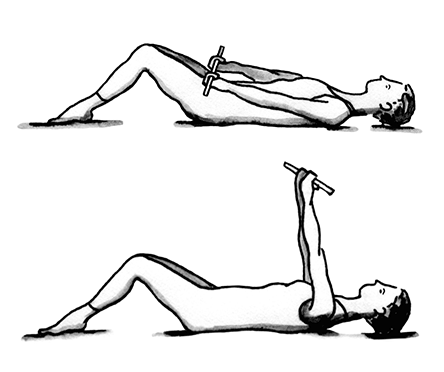
This exercise helps increase your ability to move your shoulders forward. You will need a broom handle, yardstick, or other stick-like object to use as the wand in this exercise. Do these exercises on a bed or the floor. Lie on your back with your knees bent and your feet flat.
- Hold the wand across your belly in both hands with your palms facing up.
- Lift the wand up over your head as far as you can. Use your unaffected arm to help lift the wand until you feel a stretch in your affected arm.
- Hold for 5 seconds.
- Lower arms and repeat 5 to 7 times.
Elbow winging
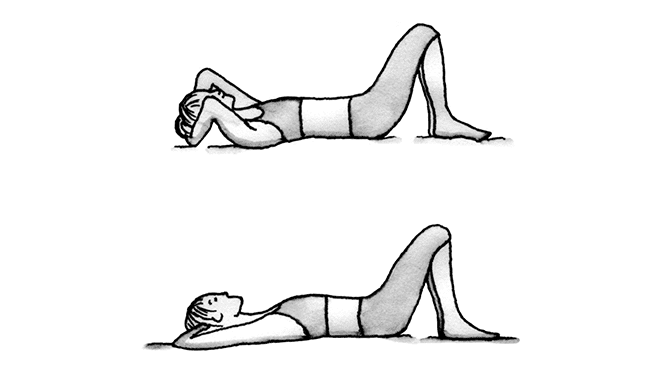
This exercise helps increase the movement in the front of your chest and shoulder. It may take many weeks of regular exercise before your elbows will get close to the bed or floor. Do these exercises on a bed or the floor. Lie on your back with your knees bent and your feet flat.
- Clasp your hands behind your neck with your elbows pointing toward the ceiling.
- Move your elbows apart and down toward the bed or floor.
- Repeat 5 to 7 times.
Shoulder blade stretch
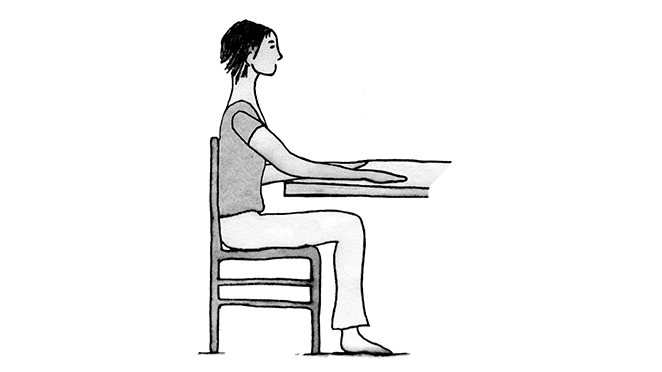
This exercise helps increase your shoulder blade movement.
- Sit in a chair very close to a table with your back against the back of the chair.
- Place the unaffected arm on the table with your elbow bent and palm down. Do not move this arm during the exercise.
- Place the affected arm on the table, palm down, with your elbow straight.
- Without moving your trunk, slide the affected arm forward, toward the opposite side of the table. You should feel your shoulder blade move as you do this.
- Relax your arm and repeat 5 to 7 times.
Shoulder blade squeeze
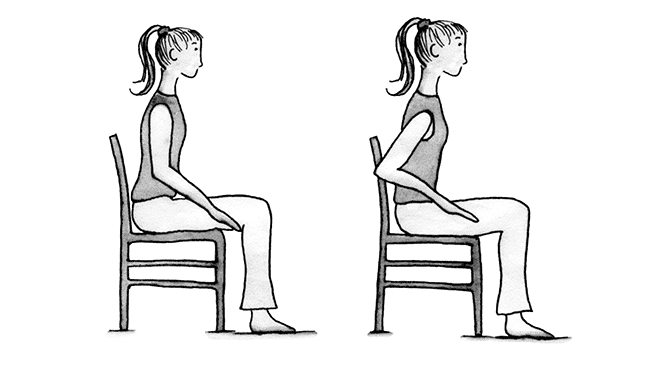
This exercise also helps increase shoulder blade movement and improve posture.
- Sit in a chair in front of a mirror. Face straight ahead. Do not rest against the back of the chair.
- Your arms should be at your sides with your elbows bent.
- Squeeze your shoulder blades together, bringing your elbows behind you toward your spine. Elbows will move with you, but don't force the motion with your elbows. Keep your shoulders level as you do this. Do not lift your shoulders up toward your ears.
- Return to the starting position and repeat 5 to 7 times.
Side bends
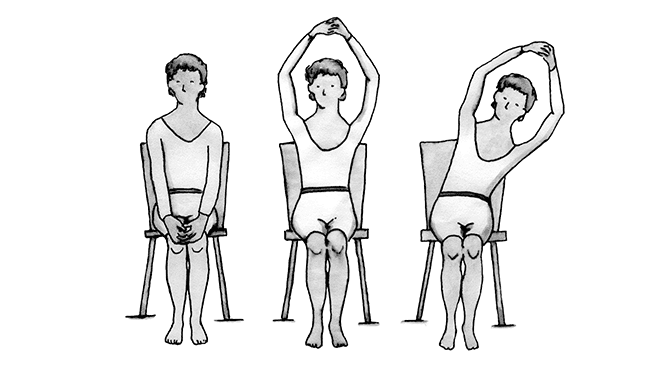
This exercise helps increase movement of your trunk and body.
- Sit in a chair and clasp your hands together in front of you. Lift your arms slowly over your head, straightening your arms.
- When your arms are over your head, bend your trunk to the right keeping your arms overhead.
- Return to the starting position and bend to the left.
- Repeat 5 to 7 times.
Chest wall stretch
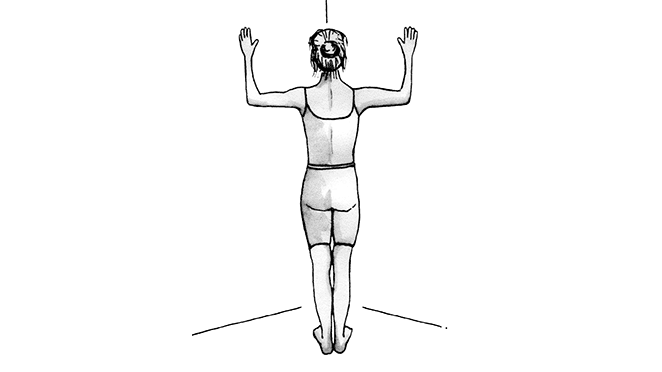
This exercise helps stretch your chest.
- Stand facing a corner with your toes about 8 to 10 inches from the corner.
- Bend your elbows and put your forearms on the wall, one on each side of the corner. Your elbows should be as close to shoulder height as possible.
- Keep your arms and feet in place and move your chest toward the corner. You will feel a stretch across your chest and shoulders.
- Return to the starting position and repeat 5 to 7 times.
- The picture shows stretching both sides at the same time, but you may find it more comfortable to stretch one arm at a time.
- Be sure you keep your shoulders dropped far away from your ears as you do this stretch. Keep your ears over your shoulders to avoid making your neck sore.
Shoulder stretch
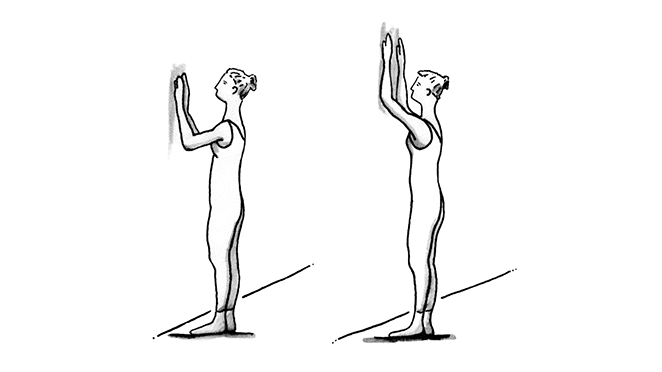
This exercise helps increase your mobility in your shoulder.
- Stand facing the wall with your toes about 8 to 10 inches from the wall.
- Put your hands on the wall. Use your fingers to "climb the wall," reaching as high as you can until you feel a stretch.
- Return to the starting position and repeat 5 to 7 times.
- The picture shows both arms going up at the same time, but you might find it easier to raise one arm at a time.
- Be sure you keep your shoulders dropped far away from your ears as you raise your arms. Keep your ears over your shoulders to avoid making your neck sore.
Things to keep in mind after breast surgery
Start exercising slowly and do more as you are able. Stop exercising and talk to your doctor right away if you:
- Get weaker, start losing your balance, or start falling
- Have pain that gets worse
- Have new heaviness, aching, tightness, or other strange sensations in your arm
- Have unusual swelling or swelling that gets worse
- Have headaches, dizziness, blurred vision, new numbness, or tingling in your arms or chest
It’s important to exercise to keep your muscles working as well as possible, but it’s also important to be safe. Talk with your doctor about the right kind of exercises for you and ask about seeing a lymphedema specialist who can help with safe exercise. Then set goals for increasing your level of physical activity.
Other kinds of exercise
Exercise to help improve aerobic (heart-lung) capacity is also important for women who have had breast cancer. There’s evidence that fitness and weight loss may even help lower the risk that some types of cancer will come back after treatment. Ask your doctor about fitness exercises during and after breast cancer treatment.
Other exercises are designed to help reduce your risk of lymphedema, or swelling in the arm, on the side where you had surgery. The exercises shown here are mainly designed to help regain range of motion (flexibility) in your arm and shoulder. Ask your doctor about your lymphedema risk and if you should use exercises to help reduce that risk.
Strengthening exercises are now recommended as part of regular exercise programs to improve health. These are not started until 4 to 6 weeks after surgery, and must be tailored to your general health, medical condition, and fitness. Strength building starts by using small hand weights, and is increased slowly over time. Again, this is best discussed with your doctor or physical therapist. It’s probably best to start a strengthening program in a supervised setting with a cancer exercise trainer or physical therapist to be sure you’re doing the exercises properly.
- Written by
- References

The American Cancer Society medical and editorial content team
Our team is made up of doctors and oncology certified nurses with deep knowledge of cancer care as well as editors and translators with extensive experience in medical writing.
Anderson RT, Kimmick GG, McCoy TP, et al. A randomized trial of exercise on well-being and function following breast cancer surgery: the RESTORE trial. J Cancer Surviv. 2012;6(2):172-181.
McNeely ML, Campbell K, Ospina M, et al. Exercise interventions for upper-limb dysfunction due to breast cancer treatment. Cochrane Database Syst Rev. 2010;(6):CD005211.
Exercise and Lymphedema: Position Statement of the National Lymphedema Network. March 2018. Accessed at https://www.mylymph.com/2018/03/08/exercise-and-lymphedema-position-statement-of-the-national-lymphedema-network on August 12, 2019.
Petito EL, Nazário AC, Martinelli SE, Facina G, De Gutiérrez MG. Application of a domicile-based exercise program for shoulder rehabilitation after breast cancer surgery. Rev Lat Am Enfermagem. 2012;20(1):35-43.
Sagen A, Kaaresen R, Sandvik L, Thune I, Risberg MA. Upper limb physical function and adverse effects after breast cancer surgery: a prospective 2.5-year follow-up study and preoperative measures. Arch Phys Med Rehabil. 2014;95(5):875-881.
Last Revised: October 27, 2021
American Cancer Society medical information is copyrighted material. For reprint requests, please see our Content Usage Policy.
American Cancer Society Emails
Sign up to stay up-to-date with news, valuable information, and ways to get involved with the American Cancer Society.


